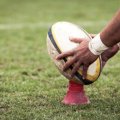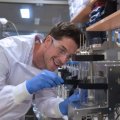People who exercise to regain muscle function after their first back injury can significantly reduce the risk of injuring their back again in the following 12 months, according to a recent University of Queensland study.
Dr Julie Hides, a researcher in the Physiotherapy Department's Joint Stability Assessment Clinic found in ultrasound studies that the body's deep back muscle, the multifidus, shrank by almost one third (30 percent) following injury.
Only 29 percent of people who exercised to return the multifidus to normal size and function suffered further back injury in the following year. However, most people - up to 80 percent - in the study who had not exercised subsequently had back injuries.
The four-year study was conducted by Dr Hides, Associate Professor Gwen Jull and Associate Professor Carolyn Richardson.
The project builds on a pilot study by Dr Hides, a Menzies scholarship winner in allied health in 1994/95, and on 10 years of research by Dr Jull and Dr Richardson on deep muscles in back pain.
In a 1994 pilot study Dr Hides observed this effect, and subsequently conducted clinical trials to observe the phenomenon over time.
She said the study supported their theory that the multifidus plays an important role in protecting the spine, controlling fine movements and reducing the back's vulnerability to further injury.
'This muscle is involved in protecting segments of one vertebrae interacting with the next.
'We conducted clinical trials to see if there was a link between muscle recovery and back pain recovery, using ultrasound to measure the multifidus after injury and at subsequent intervals.
'When people hurt their backs for the first time, their deep back muscles rapidly decreased in size at the symptomatic segment of the spine. A similar response occurs in the thigh musles when there is injury to the knee.'
The researchers studied 40 people with back injury selected at random by the accident and emergency staff at a major Brisbane hospital.
The patients received medication, time off work, bed rest or advice. Their deep back muscles were measured with ultrasound imaging.
Ninety percent of the group were pain-free after four weeks, but after a further six weeks of normal activity, the multifidus muscle did not return to normal size, even though the pain had gone.
The researchers looked at how to regain multifidus function through a managed intervention, giving 20 people physiotherapy assistance, focusing on specific exercises.
Patients were given the chance to watch their deep back muscles on ultrasound while they learned exercises to get their the muscles back to normal size and function. Attending the clinic twice a week for four weeks, they followed an exercise regime involving both the deep back and deep stomach muscles working together.
Following the regime, their deep back muscles returned to normal size and function.
Dr Hides said back pain was a serious community issue, with 80 percent of people suffering some back pain in their lives.
The project has been funded by the J.P. Kelly Foundation, the Wenkart Foundation and the Physiotherapy Research Foundation.
Dr Hides graduated bachelor of physiotherapy from the University of Queensland in 1986, master of physiotherapy studies in 1990, and PhD in 1996.
She will be a keynote speaker at a Physiotherapy Alumni symposium to mark 60 years of physiotherapy training at the University of Queensland. It will be at the University's St Lucia campus on May 30 at 9am.
Her topic will be: Introducing real-time ultrasound imaging in physiotherapy application to research and clinical practice.
The researchers are now competing a three-year followup on the original patients, and analysing data. They are still needing people without back pain to help them in the study by acting as 'controls' to further refine measures of normalcy and back pain.
People wishing to help in the study can contact Quentin Scott at telephone 07 3365 2718.
Media: For further information, contact Dr Hides, email J.Hides@mailbox.uq.edu.au or Dr Richardson, telephone 07 3365 2019, email: richardson@physio.therapies.uq.edu.au
.jpg)


